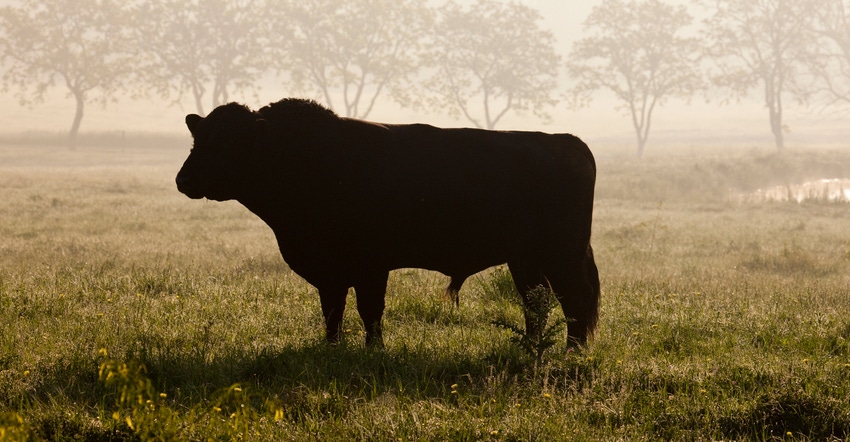February 22, 2021

Should a person wait until the hay is mowed before looking at the rake and baler to fix any problems carried over from last year? Would they head out on a cross-country drive without at least checking the oil and tires? If most people answered no to these questions, then why do so many people just turn their bull in with the cows without first being sure he is ready to do his job?
A cow-calf producer’s income comes from having calves in a timely manner, and half of that is up to the bull. A breeding soundness evaluation is an often overlooked way to avoid some potentially major problems in this year’s breeding season. Typical prices are in the $50 to $100 range, and some facilities will establish days in the spring when producers can bring their bulls to a central location for testing.
A BSE is a test performed by a trained veterinarian to estimate the readiness of the bull to settle cows. This evaluation concentrates on three aspects: physical soundness, reproductive soundness and semen quality.
Physical soundness includes evaluation of feet and legs, body condition, eyes and any other condition that could affect the bull’s ability to breed cows. Soundness of feet and legs are extremely important as the bulls increase steps taken while walking with the cow herd, but they must also be able to transfer their weight to their rear legs without pain to consistently service the cows.
Adequate body condition also is important as the bull will be more active during breeding season and will be using excess body stores to maintain energy.
Reproductive soundness is evaluated by internal and external palpation. Reproductive secondary organs such as the seminal vesicles and prostate are palpated internally. The penis, testis and scrotum are examined externally. Malformations, inflammation and scrotal measurements are prime targets of the reproductive soundness portion. More detail on scrotal measurements will come later.
Semen quality is evaluated by collecting a semen sample by using electro-ejaculation. This is not the unpleasant experience the name may suggest. Think of it more as the electrical muscle stimulation you may receive in therapy and not the electric fence charger. Semen is then evaluated for motility, morphology (normal shaped sperm) and any abnormal fluids such as blood or pus.
Studies indicate that 1 of 5 bulls evaluated will not be scored as a satisfactory potential breeder. These bulls can be retested in 60 days for a potential change in status. The 60-day window is set because that is about how many days it takes for a sperm cell to complete the growth and maturation process.
Changes to the bull’s health or environment any time during the 60-day cycle can result in drastic changes in sperm. This includes things such as sickness, fever, extreme heat, extreme cold, stress and injury. Sometimes that 60-day wait will be enough for sperm quality to improve.
The BSE should be conducted every year about 30 to 60 days before the breeding season. Just because you had good conception rates last year does not mean you will this year. Many things can happen during the bull’s offseason that could affect fertility, including natural aging.
Scrotal circumference
Minimum scrotal circumference standards have been established based on the age of the bull. Even though your bull may meet the minimum, there are reasons larger circumferences are important.
The scrotal circumference measurements taken during the BSE are excellent predictors of many traits. The heritability of scrotal circumference is often estimated at near 0.70, which is much higher than many growth traits and similar to the heritability of carcass traits. Above-average scrotal circumference is highly correlated to earlier onset of puberty in offspring. This is true for both bulls and heifers. The circumference is also strongly correlated to pregnancy rate and female lifetime productivity.
Every additional cycle a cow remains open is 21 less days of growth on that cow’s calf the next year. This amounts to about 55 pounds lower weaning weight, which at $1.40 feeder calves is a loss of $77. This does not factor that cow will be 21 days behind for the next breeding season since it is always a challenge to move cows up in the breeding season.
A subpar fertility bull can cost you money and push your calving season back, but if that subpar turns into a situation where only a few cows or possibly no cows settle, that can be a major setback. With the Ohio average herd size of 17 cows, not many have a backup bull in place.
A BSE is a cheap insurance policy when so much rides on the performance of one animal. There is no guarantee it will prevent all issues as it is just looking at one day in that bull’s life, but it will help prevent many issues.
Kreager is the AgNR educator in the Licking County OSU Extension office and a member of the OSU Extension Beef Team. The team publishes the weekly Ohio BEEF Cattle letter, which can be received via email or found at their website, beef.osu.edu.
You May Also Like




